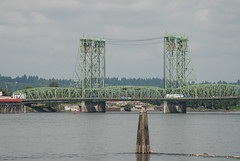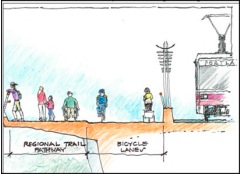
the Columbia.
(Photo © J. Maus)
We reported last week that the Bicycle Transportation Alliance has decided to resign from the the Bicycle and Pedestrian Advisory Committee for the Columbia River Crossing project.
A new post to the BTA blog by advocate Michelle Poyourow goes into detail about this decision. The post particularly outlines the BTA’s concerns about the project’s direction, its process, and their disappointment in the evolution of was once touted as a “world class” bicycle and pedestrian facility.
All members of the committee except for Poyourow voted last week to recommend an under-deck bicycle path, contingent on a strict maintenance and security agreement. Poyourow’s blog post provides a thorough analysis of the proposal’s shortcomings, including its situation under the deck, its “long, loopy, hilly,” nature, and its lack of access points. She adds that she does not believe that a strong maintenance agreement will come about, and that “there is no reason to expect this under-bridge path not to fail.”
The post states (emphasis original):
“The BTA can no longer justify pouring our members’ precious resources into a project that is bad for the health and vitality of this region and now has a lousy bike and pedestrian facility to boot.”
Poyourow told BikePortland on Friday that she believes the BTA can effectively influence the project without sitting on — and thereby tacitly endorsing — the committee.
“The problem with the CRC is it’s just been deaf to community input,” she said, adding that bicycle advocates are not the only group to have had concerns about the bridge brushed aside. “They’re not listening. They’re determined to do what they’re going to do.”

with a 6′ bike lane and 12′ path
on each side of the bridge was
recommended by the BPAC for the Three
Bridge option in June 2008
Poyourow made clear that the BTA will continue to be invested in the outcome of the CRC process. “People really want to see a great, multi-modal connection across the river,” she said, “but the CRC project has not listened to the very valid community concerns and desires for this project. We’ll be looking to support alternative processes and plans that do take these concerns and values into account.”
She said that the Coalition for a Livable Future has “provided a helpful gathering place, to share ideas about strategy and be in touch with people concerned not just about bikes.”
The BTA is deciding on its next steps beyond fully explaining its concerns to the project sponsors. Poyourow said they are actively working with other local groups to identify a viable alternative proposal that they can support, and plan to work directly with local and federal politicians, funders, and stakeholders to develop what Poyourow hopes will be “a real solution — not a false solution.”
As for the viability of the current plan on the table for the project, Poyourow said, “I don’t think what they’re proposing now will come to pass. I hope something happens. But not this.”
– See our full coverage of the Columbia River Crossing design process, funding, politics, and opposition here

